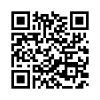REVOLUTIONING COMMUNICATION IN NOVEL KEKASIH TERJAUH BY DWITASARI
Downloads
(Title: Revolutioning Communication in Novel "Kekasih Terjauh" by Dwitasari). The rapid development of technology is running these days. Progress in communication technology make communication between individuals easier and more convenient. The requirement for social interaction causes everyone need communication. Communication and literary works cannot be separated. The way of communication changes with the times. Language as an important element in literature also changes. There is internet which is change our perception about communication. This research will discuss the communication that occurs between the characters in the novel "Kekasih Terjauh" by Dwitasari. The problem in this research is about the revolutioning communication used by the characters in the novel "Kekasih Terjauh". While the purpose of this research is to determine the the revolutioning communication that is taking place in the novel "Kekasih Terjauh". The methodology used is descriptive analysis with literature study as a data collection technique. This research uses theory of character, setting, communication, and also sociology of literature.
Keywords: communication, internet, revolution, technology
Downloads
Aminudin. (2002). Pengantar Apresiasi Karya Sastra. Bandung : Sinar Baru.
Dwitasari. (2018). Kekasih Terjauh. Jakarta : Falcon Publishing.
Effendy, Onong Uchjana. (2002). Komunikasi Teori dan Praktek. Bandung:bRemaja Rosdakarya.
Farouk. (2010). Pengantar Sosiologi Sastra. Yogjakarta : Pustaka Pelajar.
Hjarvard, S. (2008). The Mediatization of Society, A Theory of the Media as Agents of Social and Cultural Change. Nordicom Review, 29(2), 105–134.
https://www.researchgate.net/publication/313789652_The_Mediatization_of_Society
Hovland, C, Janis, I and Kelley, H. (1953). Communication and Persuasion. New Haven, GT: Yale University Press.
Kellogg, W. A. (2003). Environmental Justice and Information Technologies : Overcoming the Information Access Paradox in Urban Communities. Public Administration Review, 63(5), 573–585.
Kietzmann, J. H., Hermkens, K., McCarthy, I. P., & Silvestre, B. S. (2011). Social Media? Get Serious! Understanding the Functional Building Blocks of Social Media. Business Horizons, 54 (3), 241-251.
Nurgiyantoro, Burhan. (2007). Teori Pengkajian Fiksi.
Yogjakarta : Gadjah Mada University Press.
Ratna, Nyoman Kutha. (2008). Teori, Metode, dan Teknik Penelitian Sastra. Yogjakarta: Pustaka Pelajar
Ruben, Brent D, and Lea P. Stewart. (2005). Communication and Human Behaviour. Boston : Alyn and Bacon Incorporated.
Trenholm, Sarah and Arthur Jensen. (2013).InterpersonalCommunication. Oxford : Oxford University Press
The authors who publish this journal agree to the following requirements. The author retains the copyright regarding the work being simultaneously licensed below Creative Commons Attribution ShareAlike License.

Jurnal Diksi by Faculty of Languages, Arts, and Culture, Universitas Negeri Yogyakarta is licensed under a Creative Commons Attribution-ShareAlike 4.0 International License.
Based on a work at http://journal.uny.ac.id/index.php/diksi




















